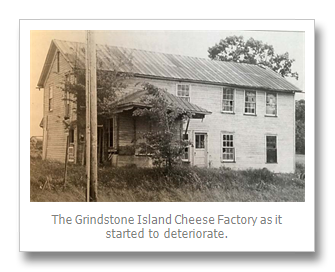Written by
Audrey Lashomb posted on January 13, 2017 12:45
The following is a chapter from “Going Home: Grindstone Island” written by Audrey Lashomb and published in 1998. This history book is out of print, but we highly recommend you look for one… It is a must for all Island libraries.
The late Aminta Marks, a fellow Grindstone Island resident, wrote the forward to the book, In part, she wrote: “Audrey Lacombe’s book begins at home and chronicles the lives of her forebearers, her immediate family, her neighbours, and a wealth of Grindstone Islands friends. Beginning with the early history of the Indians who summered in the “garden” of Grindstone, she briefly traces the economic development of the island, through the years of logging, farming, quarrying, cheese-making and finally the hard times of small farmers, and the changes in island life since her childhood.
[Cover: A painting by Aminta Marks depicting the last day of school in 1989, after which the doors were closed for good.] |
Cheese Factory
About 1892, at the same time the quarries were closing, a cheese factory was built and the manufacturing of cheese began. Grindstone Island cheese was known for its very high quality and sold all over the country. The milk was drawn to the factory in 30-gallon cans by horse and milk cart from all the farms. Over 30 farm families at a time brought their milk to be made into cheese. The original cheese factory burned down in October 1918 and was rebuilt and reopened in Spring of 1919. (Reference: “Emmet Dodge Memoires”).
I remember riding with my grandfather Turcotte and my father some mornings. The milk carts were pulled by a team of horses if there were heavy loads and muddy roads. If the farm was small, and the cheese factory only a short distance away, the farmer could pull the cart with one horse. The factory was over two miles from our farm in Thurso, so the slow pace of the two horses gave us comfortable family time together.
As we arrived at the factory, we took our place in line to approach the unloading zone. There, big hooks swung out to hook on the side handles of the 30 gallon cans. Two people stood on the platform to lift the bottom of the can for dumping. Once back in the milk cart, we drove to a whey vat to fill our empty cans with whey. This was taken back to the farm for the pigs. Before going home we would always buy a chunk of cheese wrapped in brown paper to take with us. We used to break off a few pieces to nibble on, for the return trip home to breakfast.
In the winter, the cows were gradually “dried up” for spring calving. The milk that was available was separated into cream and shipped to the mainland to be sold.
This brings me to the only story told to me by an islander regarding the prohibition days. Grindstone Island is halfway between Canada and the U.S. mainland. The head of Grindstone, quite sparsely populated, was a dropping off point from Canada. Three, stealthy U.S. mainlanders would creep up by foot or boat after dark and retrieve the haul at a pre-arranged spot. These “spots” were underwater marked with a buoy or simply at some landing along the shoreline.

One of the farms at the head of the island used to supply a few people of Clayton with illegal liquor. The federal agents watched the island people very closely and one day they met the island boat on its daily run. It was loaded with ten-gallon cream cans from the farm at the head of the island. They searched the boat passengers thoroughly and even helped load the cream cans onto the truck before going on their way. What they didn’t know was that the cream cans were full of liquor bottles. The farmer had turned the cream screw, adjusting the thickness of the cream way up, then he submerged the bottles into the cream. This way they were out of sight and well padded. it was a big laugh to the famer that the”feds” had the liquor in their hands at one time and didn’t know it.
After a time, the younger generation would go off the island to World War II, school or to work for the war effort; and once an easier way of life was put before them, their desire to take over the family farms diminished. As the older generation became too old to continue, the cattle were sold and the farms lay in disrepair. The few farms that remained operable, switched from milk cows to beef cattle. The Cheese Factory closed for good in 1957.
|
|
“Going Home: Grindstone Island”
c/0 Audrey Lashomb, 34771 Wood Road, Clayton,
New York,13624
$20.00 plus shipping
|
By Audrey Lashomb, published in “Going Home: Grindstone Island” 1998.
Audrey Turcotte Lashomb, 86, was born and raised on Grindstone Island, the 4th largest island in the 1000 island. Audrey authored the book, “Going Home: Grindstone Island.” She and her husband Bob, also from Grindstone, were educated in the one room school house on the island. They later owned and operated Remar Rentals and Remar Shipyard in Clayton while still commuting from their island home. Audrey continues to document Island history and remains true to her Island roots.